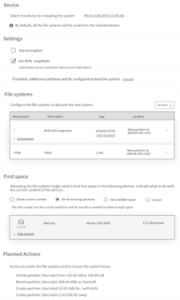The Year of Agama – an outlook to the 2024 roadmap
 The following article has been contributed by Ancor González Sosa and the YaST team at SUSE.
The following article has been contributed by Ancor González Sosa and the YaST team at SUSE.
At the end of 2023, we announced Agama 7, a new service-based installer for Linux. That version was the first prototype we could consider to be ‘functional enough’ for our purposes, as it covers areas such as localization, network configuration, storage setup, authentication basis and some software selection.
Now it’s time to go deeper into every area… and we have a plan for that.
The Agama Roadmap for 2024
They say “plans are useless, but planning is indispensable”. So, we decided to do the indispensable exercise of planning the first months of 2024 – and we came up with this ‘useless plan’ 😁.
Although we will keep delivering new versions of Agama at a constant pace, we established two milestones as check points. The first milestone is expected around mid April, the second one is scheduled for mid July. Then we used those two milestones to group the next tasks we want to tackle.
April’s milestone should result in a
- revamped architecture for Agama which does no longer depend on Cockpit.
- in a more comprehensive user interface for configuring the storage setup.
Both aspects are explained in depth below.
July’s milestone should bring mechanisms to make Agama more adaptable. In addition, it provides many improvements to unattended installation, turning Agama into a worthy contender to AutoYaST.
Let’s dive into the improvements expected for the first milestone.
Architectural Changes
So far, we have built Agama on top of the infrastructure provided by the Cockpit project. That allowed us to bootstrap the project quickly without having to invest too much on aspects like authentication or serving files to the web interface. But after more than a year of Agama development we now have a clear view on how we want to do certain things. Unfortunately, Cockpit was starting to feel like a limiting factor.
In consequence of our discussions, we concluded the small of amount of functionality we are getting out of Cockpit does not justify the strong dependency, especially now that Cockpit is adopting Python as an integral part of its runtime. In consequence we will invest the following months in changing a bit the approach (find the entire discussion and more details here). That should unblock many paths to improve Agama in the near future.
A more powerful user interface for the storage proposal
The architectural changes are important for remote or unattended installation. They will also simplify the integration of Agama into bigger solutions. However, they may not be visible to the casual user. That doesn’t imply next months will be boring in respect of interactive installation. Quite the opposite, we plan many improvements in Agama’s proposal page that allows to tweak the storage configuration.
The new interface aims to be easy enough for newcomers, as you can see in the following mock-up. But we know (open)SUSE users have big expectations in terms of customizing their setups. Thus, we updated the document that describes how the new interface will work and all the options it will offer for those who decide to go beyond the initial proposal. If you want to check whether your basic needs are covered, take a look at the document and the extended mock-ups included on it.

If interface descriptions and mock-ups are not your cup of tea, worry not. We already started implementing some parts of the new interface, so you will be able to try the changes for real as they land incrementally at upcoming Agama prototypes.
openSUSE Conference on the horizon
If you look at the dates of both milestones described above, you will notice there is something happening almost in the middle – openSUSE Conference 2024 – which will take place in June!
We hope at that point in time Agama will be able to replace YaST for some scenarios and distributions. Of course, we would like to use the conference to chat with users and the community about the possible future of Agama at (open)SUSE.
Fundamentally, the installation experience goes beyond the installer itself. The environment in which the installer is executed is also a crucial aspect. Apart from replacing YaST with Agama, we would need to replace the current so-called ‘installation image’ with a modern alternative. So far, the Agama test Live ISO has served us for demo purposes, but we would appreciate any help with building a system suitable for more real installation scenarios.
If you have good ideas about reducing the size of the live image, properly integrating the distribution repositories into it, streamlining the boot process, or any other topic, please reach out to us.
Stay in touch
Your contributions and opinions are a key element to make sure Agama reaches its goals. Don’t hesitate to contact the YaST team at the YaST Development mailing list, our #yast channel at Libera.chat or the Agama project at GitHub.
Related Articles
Feb 15th, 2023
Ransomware Attacks – Part 2, Traditional IT Security
May 03rd, 2023